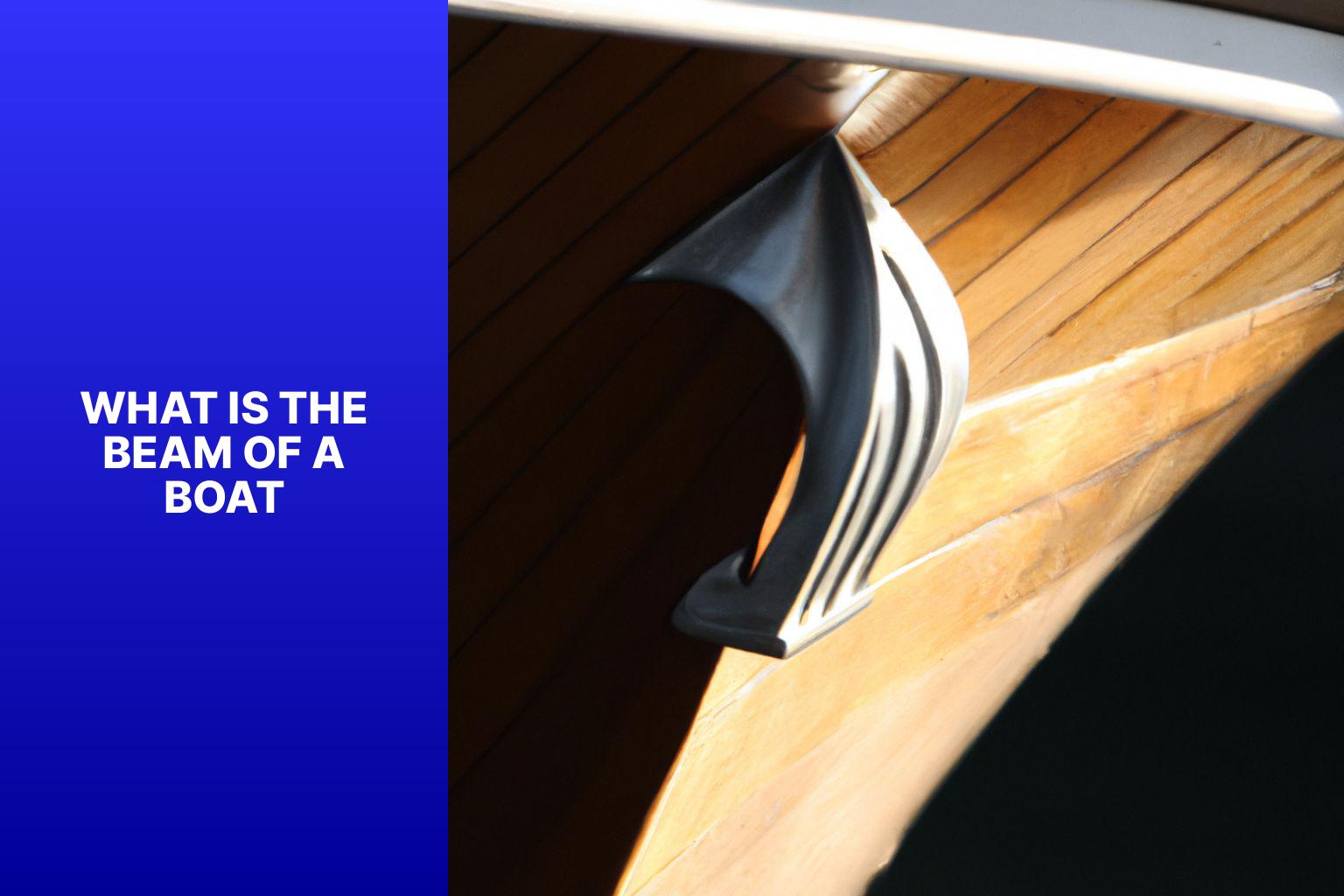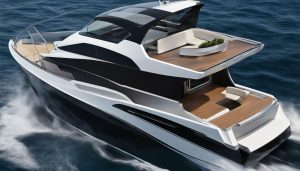Boat enthusiasts and sailors are often familiar with various nautical terms, but beginners may find some concepts confusing. One such term is the “beam” of a boat. Understanding the beam is essential for anyone interested in boats and boating. So, what exactly is the beam of a boat?
The beam of a boat refers to its width at its widest point. It is the measurement taken from one side of the boat to the other, at the broadest part of the hull. The beam is often presented as the “width” of a boat and is an important characteristic when considering the boat’s design, stability, and overall performance.
The boat beam holds immense significance for several reasons. First and foremost, it plays a crucial role in determining the stability of the boat. A wider beam generally results in increased stability, making the boat less likely to tip or roll over in rough waters. The beam directly affects the space and comfort available onboard. A wider beam allows for more interior space, making the boat more comfortable for passengers and facilitating various activities like fishing, dining, and sleeping.
Boats come in different types, and each requires a specific beam design to ensure optimal performance and functionality. There are two main types of beams: narrow beam and wide beam. Narrow beam boats have a slimmer width, which allows for increased speed and maneuverability. On the other hand, wide beam boats offer enhanced stability and a more spacious interior.
Several factors influence the beam of a boat. The size and type of the boat are key factors in determining the appropriate beam width. The intended use of the boat, whether for recreational purposes, fishing, or commercial activities, influences the ideal beam measurement.
Measuring the beam of a boat is a straightforward process. It involves measuring the distance between the widest points on either side of the boat’s hull. This measurement provides an accurate representation of the boat’s beam width.
When choosing the right beam for a boat, several factors should be taken into consideration. Boat stability needs are of primary importance, as different activities and water conditions require varying levels of stability. Maneuverability and overall performance are also key considerations. Cargo and passenger capacity should be evaluated to ensure the boat can accommodate the intended purpose effectively.
Understanding the concept of the boat beam is essential for boating enthusiasts and individuals considering boat ownership. It impacts stability, space, comfort, and overall performance. By familiarizing themselves with the beam and its various aspects, individuals can make well-informed decisions when it comes to selecting the right boat for their needs.
Key takeaway:
- Boat beam refers to the width of a boat, measured at its widest point. It is an important measurement in the design and functionality of a boat.
- The beam of a boat is important for stability, as a wider beam provides more stability and helps prevent the boat from capsizing.
- The boat beam also impacts the space and comfort of the boat, with a wider beam allowing for more interior space and a smoother ride.
What is the Beam of a Boat?
The beam of a boat – it’s not just another technical term, but a crucial aspect that determines a boat’s stability and spaciousness. In this section, we’ll dive into the definition of boat beam and uncover what exactly it entails. Get ready to discover the fascinating details behind this essential feature of naval architecture and how it impacts a boat’s performance on the water. So, buckle up and prepare to set sail on this enlightening journey into the world of boat beams.
Definition of Boat Beam
Boat beam, defined as the width of a boat at its widest point, is an essential factor in determining the vessel’s stability. Measured in feet or meters, the beam is the distance from one side of the boat to the other.
A wider beam generally offers more stability, while a narrower beam allows for better maneuverability.
Not only does the boat’s beam affect its stability and maneuverability, but it also impacts the available space onboard. With a wider beam, there is more interior space and comfort, whereas a narrower beam may limit the available space.
The size and type of the vessel play a significant role in determining the boat’s beam. Smaller boats tend to have narrower beams, while larger boats have wider beams.
Understanding the definition of boat beam is crucial in making an informed decision when choosing the right boat for your needs.
Why is the Boat Beam Important?
When it comes to boats, one factor that often gets overlooked but plays a crucial role is the boat beam. So, why is the boat beam important? In this section, we’ll uncover the significance of the boat beam in two key aspects: stability and space and comfort. Hang on tight as we sail through the reasons why this often underestimated element can make or break the boating experience.
Stability of the Boat
When it comes to the stability of a boat, there are several factors to consider:
1. Hull design: The shape and size of the boat’s hull play a crucial role in stability. A wider hull provides greater stability compared to a narrower one.
2. Beam width: The width of a boat, known as the beam, directly affects stability. A wider beam distributed over a larger surface area enhances stability, especially in rough waters.
3. Weight distribution: Properly distributing weight is essential for maintaining stability. Placing the weight too high or unevenly can negatively impact stability, potentially causing the boat to tip or roll.
4. Buoyancy: The ability of a boat to stay afloat is fundamental for stability. A boat with good buoyancy is less likely to capsize or become unstable in challenging conditions.
5. Center of gravity: The boat’s center of gravity should be low and centered to maximize stability. This helps counterbalance external forces like waves or wind.
6. Ballast: Some boats use ballast, such as additional weight or water tanks, to improve stability. This extra weight lowers the center of gravity and helps keep the boat upright.
7. Hull shape: Different hull shapes offer different levels of stability. For example, a flat-bottomed hull provides excellent initial stability, while a V-shaped hull offers better stability in rough conditions.
By considering these factors and selecting a boat with the appropriate stability features, you can ensure a safer and more enjoyable boating experience.
Space and Comfort
When considering a boat’s space and comfort, several factors should be taken into account. These factors include seating capacity, legroom, storage capacity, movement space, and stability.
Seating capacity is directly affected by the boat’s beam. A wider beam allows for more seating options and allows passengers to spread out and relax, providing a spacious and comfortable experience. Similarly, a wider beam provides ample legroom, contributing to a more comfortable and enjoyable boating experience.
A wider beam often means more storage space on a boat, which can greatly enhance comfort by providing room to store personal belongings, fishing equipment, or other items needed for a day on the water. It also offers more space for passengers to freely move around the boat, especially during activities such as fishing or water sports, where freedom of movement is essential for a comfortable experience.
A wider beam generally provides better stability, reducing the risk of tipping or swaying. This not only adds to the overall comfort but also ensures a secure feeling while on the water. So, when looking for a boat, it is important to prioritize space and comfort to ensure a pleasant and enjoyable boating experience.
Types of Boat Beam
Types of Boat Beam – Discover the varying beam widths in boats, from narrow to wide, and delve into the differences between the two. Whether you’re interested in a more agile and maneuverable vessel or a stable and spacious one, understanding the significance of beam width is crucial. Get ready to compare the pros and cons of narrow beam boats versus wide beam boats, and gain insights into the factors that can impact your boating experience. Get ready to set sail!
Beam Width
The beam width of a boat is an important factor to consider when selecting the appropriate vessel. It is defined as the widest point of the boat, measured from one side to the other. The beam width directly impacts the boat’s stability, maneuverability, and capacity.
To comprehend the significance of beam width, let’s visualize a table:
| Narrow Beam | Wide Beam | |
| Stability | Less stable | More stable |
| Maneuverability | Improved maneuverability | Less maneuverable |
| Cargo and Passenger Capacity | Lower capacity | Higher capacity |
A narrow beam offers better maneuverability in tight spaces but compromises stability, particularly in rough water conditions. On the other hand, a wide beam provides enhanced stability for a smoother ride and increased cargo and passenger capacity, which is ideal for larger groups or carrying more equipment.
When choosing the appropriate beam width for a boat, specific needs should be considered. If maneuverability and agility are essential, a narrow beam may be the preferred choice. If stability and capacity are of greater importance, a wider beam will be more suitable.
Comparing Narrow Beam vs Wide Beam Boats
| Comparison Factor | Narrow Beam Boats | Wide Beam Boats |
| Stability | Narrow beam boats are less stable. | Wide beam boats offer better stability, especially in rough waters. |
| Maneuverability | Narrow beam boats are more maneuverable, making them suitable for fishing or sailing in narrow channels. | Wide beam boats are less maneuverable and may require more space for turning or docking. |
| Space | Narrow beam boats have limited interior space, affecting comfort and storage capacity. | Wide beam boats provide more interior space, enhancing comfort and storage options. |
| Speed | Narrow beam boats are generally faster due to their streamlined design. | Wide beam boats may sacrifice speed for stability and a smoother ride. |
When comparing narrow beam boats and wide beam boats, consider your specific needs and preferences. If stability is a priority, especially in rough waters, choose a wide beam boat. For maneuverability, such as fishing or navigating narrow channels, a narrow beam boat is suitable. Consider the space needed for passengers and storage, as wide beam boats offer more interior space. If speed matters, narrow beam boats tend to be faster due to their sleek design. Ultimately, the decision between narrow beam and wide beam boats depends on your preferences and the boating activities you plan to engage in.
Factors Affecting the Beam of a Boat
When considering the beam of a boat, there are a few key factors that come into play. We’ll take a closer look at how boat size and type, as well as the intended use of the boat, can significantly influence its beam. It’s fascinating to see how these elements shape the overall stability and functionality of a vessel. So, let’s dive in and explore the intriguing world of boat beam and its multifaceted dynamics!
Boat Size and Type
When it comes to choosing a boat, understanding the impact of boat size and type on performance and functionality is crucial. The comparison table below provides information on different boat sizes and types:
| Boat Size | Boat Type |
|---|---|
| Small | Canoe, Kayak, Dinghy |
| Medium | Center Console, Bowrider, Pontoon |
| Large | Cabin Cruiser, Yacht, Sailboat |
The size of the boat plays a significant role in its stability, maneuverability, and overall comfort. Smaller boats like canoes and kayaks are ideal for navigating narrow waterways and enjoying solo or small group adventures. Medium-sized boats, such as center consoles and bowriders, offer a mix of space, versatility, and speed, making them suitable for a range of recreational activities. On the other hand, large boats like cabin cruisers and yachts provide ample space for overnight stays, entertaining guests, and long-distance cruising.
The type of boat determines its purpose and features. Each boat type is designed for specific activities such as fishing, watersports, or cruising. Fishing boats come equipped with specialized gear and storage compartments, while sailboats rely on wind power for propulsion. By carefully considering the appropriate boat size and type that aligns with your intended use and personal preferences, you can ensure a gratifying and fitting boating experience.
Intended Use of the Boat
The intended use of the boat is crucial when selecting the appropriate beam width. For fishing purposes, it is advisable to opt for a narrower beam as it allows for easier maneuverability in tight areas. On the other hand, for recreational boating and cruising, a wider beam provides enhanced stability and ample space for passengers. In the case of water sports, a wider beam is beneficial as it improves stability and provides a better platform for various activities. For commercial or cargo purposes, a wider beam is advantageous as it facilitates the transportation of larger loads and ensures stability. Understanding the intended use of the boat is essential in determining the optimal beam width for optimal performance, safety, and comfort during specific activities.
Let me tell you a true story: A group of friends embarked on a fishing expedition. They had plans to navigate through narrow waterways to reach their favorite fishing spot. They soon realized that the wide-beamed boat they had rented was ill-suited for this task. Maneuvering the boat in tight spaces proved to be challenging, and they faced difficulties in effectively casting their fishing lines. Frustrated, they had no choice but to abandon their original plan and search for an alternative fishing spot accessible via a narrower waterway. This experience taught them the significance of considering the intended use of the boat and selecting the appropriate beam width to ensure a successful and enjoyable boating experience.
How to Measure the Beam of a Boat?
How to Measure the Beam of a Boat?
To measure the beam of a boat, follow these steps:
1. Position the boat on stable and level ground or in the water.
2. Find the widest point of the boat’s hull, typically in the center.
3. Use a measuring tape to measure the distance between the outer edges of the hull at the widest point. This is the beam.
4. Make sure the measuring tape is straight and parallel to the waterline for accuracy.
5. Record the measurement in inches or centimeters.
Pro-tip: Take multiple measurements at different points along the beam to calculate an average for a more precise measurement.
Considerations for Choosing the Right Beam for a Boat
When it comes to choosing the right beam for a boat, there are several key considerations to keep in mind. From ensuring boat stability and maneuverability to maximizing cargo and passenger capacity, each aspect plays a vital role in the overall performance of the vessel. So, let’s dive into these essential factors and discover how the right beam can make all the difference in your boating experience.
Boat Stability Needs
Boat stability needs are crucial when choosing the right beam. Proper weight distribution is crucial for boat stability. Boat stability needs also depend on sea conditions. Different boats have different stability needs based on sea conditions. In rough waters, boat stability needs are higher and a wider beam provides better stability and reduces the risk of capsizing. In calmer waters, a narrower beam may be enough for boat stability.
The size of the boat also affects boat stability needs. Larger boats require a wider beam for stability as they carry more weight and are affected by wind and waves. Boat stability needs also depend on the activities onboard. The activities you plan to do on the boat can impact stability needs. Fishing, diving, and other movement-heavy activities require a wider beam for a stable platform.
Boat stability needs are influenced by the number of passengers and amount of cargo. The number of passengers and amount of cargo affect stability needs. A wider beam allows for more space and weight capacity, accommodating passengers and cargo without compromising stability.
Considering all these boat stability needs will help you choose the right beam, ensuring a safe and enjoyable experience on the water.
Maneuverability and Performance
When considering a boat’s maneuverability and performance, several factors are important: boat length, hull design, steering system, propulsion system, and weight distribution.
Boat length greatly affects maneuverability and performance. Shorter boats are more agile and responsive, while longer boats offer better stability at high speeds and in rough waters.
The shape and design of the hull also impact maneuverability and performance. A deep V-shaped hull handles waves and choppy waters better, providing a smoother ride and better maneuverability. On the other hand, flat-bottomed hulls are more stable at slower speeds but may struggle in rough waters.
The type of steering system in a boat also plays a role in maneuverability and performance. Hydraulic or power-assisted steering systems offer more precise control and ease of handling, especially at higher speeds. Mechanical steering systems may require more effort to steer, particularly in larger boats.
The type of propulsion system, such as outboard motors or inboard engines, can also affect maneuverability and performance. Outboard motors are more maneuverable and offer greater control due to their ability to be steered and tilted. Inboard engines may provide more power and stability.
Proper weight distribution is crucial for maintaining stability and maneuverability. Placing heavy items or passengers in the wrong areas of the boat can disrupt its balance and handling. Following the manufacturer’s recommendations for weight distribution is essential for optimizing maneuverability and performance.
Regular maintenance and upkeep, including cleaning and inspecting the propeller, hull, and steering components, can help optimize a boat’s maneuverability and performance over time.
Cargo and Passenger Capacity
To choose the right boat beam for your needs, it is important to consider the cargo and passenger capacity. Evaluating the available space will allow you to determine if the boat can accommodate the necessary cargo and the desired number of passengers.
Here is the summary of the cargo and passenger capacity for different boat types:
–
—
| Fishing Boat: | This boat has a cargo capacity of 500 lbs and can accommodate 4 people. |
| Pontoon Boat: | With a cargo capacity of 1200 lbs, this boat can comfortably seat 10 people. |
| Ski Boat: | With a cargo capacity of 300 lbs, this boat can accommodate 6 people. |
| Sailboat: | This boat has a cargo capacity of 600 lbs and can accommodate 2 people. |
For instance, if you are planning fishing trips with your friends, a fishing boat with a cargo capacity of 500 lbs and the ability to accommodate 4 people would be suitable. On the other hand, if you enjoy hosting larger gatherings on the water, a pontoon boat with a cargo capacity of 1200 lbs and a passenger capacity of 10 people would be more appropriate.
Considering the cargo and passenger capacity is crucial as it ensures there is enough room to store equipment, supplies, and personal belongings. It also prioritizes the comfort and safety of your passengers, giving everyone the opportunity to fully enjoy the boating experience without feeling overcrowded.
Some Facts About What Is The Beam of a Boat:
- ✅ The beam of a boat refers to the width of the vessel, specifically the widest distance between the hull’s gunwales or the port and starboard sides. (Source: Boating Basics Online)
- ✅ The beam is important for navigation and determining the direction of and from the vessel. (Source: Boating Basics Online)
- ✅ The beam can also be measured in terms of the beam waterline, which is the width of the hull relative to the ship’s waterline, and the beam centerline, which applies to multihulls and refers to the distance between the vessel’s respective hulls. (Source: Boating Basics Online)
- ✅ Boatbuilders pay attention to the ideal beam to length ratio, with a classical ratio of 3:1 considered safe and solid. (Source: Boating Basics Online)
- ✅ Wide beam boats are known for their stability and spacious decks. (Source: Boating Basics Online)
Frequently Asked Questions
What is the beam of a boat?
The beam of a boat refers to the width of the boat, measured at its widest point.
How does the beam width affect a boat’s stability and speed?
Wider boats are more stable, while narrower boats are faster.
How is the beam of a boat measured?
The distance from port to starboard at the widest point is the beam of the boat. Multi-hulled boats measure the beam by the distance between the centerlines of the hulls, while monohull vessels measure it across the width of the boat.
What is the ideal beam width for a boat?
The ideal beam width depends on the boat’s capabilities and needs. Boats with wider beams are more stable and can handle rough water better.
What is the importance of the beam in maritime navigation?
The beam of a boat plays a crucial role in navigation and determining the direction of and from the vessel. The port beam and starboard beam are often used as points of reference for navigation.
How can the stability of a boat be improved?
A boat’s stability can be improved by having a wider beam, which provides better stability and the ability to right itself after tipping over.



